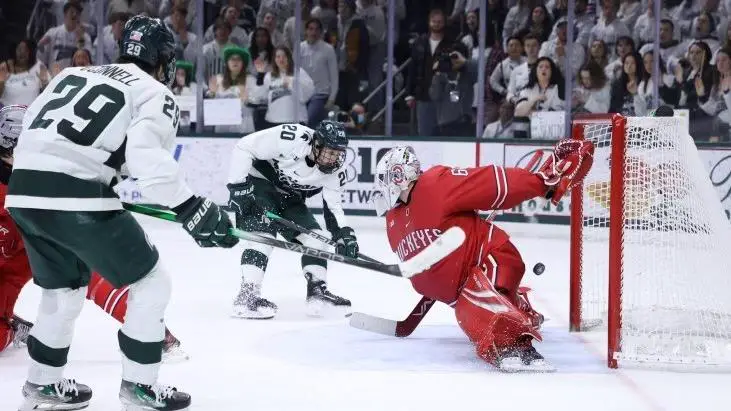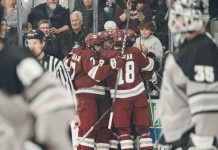
Each week during the season, we look at the big events and big games around Division I men’s college hockey in Tuesday Morning Quarterback.
Dan: Good morning and happy Tuesday, where temperatures are looking a lot like springtime in the great Commonwealth of Massachusetts. I had sunny skies and a 50-degree day on Monday, and it looks like more of the same for Tuesday and Wednesday this week. Not sure if that means I’ll need to dig up the golf clubs, but it does tell me that I at least need to locate their whereabouts…
Speaking of golf clubs, we’re getting near the end of the season, which means teams and players are going to start summer vacations as early as this upcoming weekend. We’ll get to what that means in a little bit, but I want to start with you, Paula, about what happened this past weekend in Fairbanks.
I don’t think it needs much introduction, but for those who didn’t watch the viral highlight, Alaska and Arizona State’s first game ended with under 12 seconds remaining in the third period because of a line brawl that produced 200-something penalty minutes. Two players left their respective penalty boxes to throw hands, and the highlight reel made the rounds on Saturday, Sunday, and Monday as we await further word of what’s going to happen…though I’m guessing both players involved won’t be playing much hockey before their respective seasons end.
Fighting is always a hot button topic in hockey, so I guess we can start with your overall impression of what happened. From there, I do want to dive into the topic a bit and see how our opinions compare.
Paula: All I have to go on is the box score and the viral video, and I am absolutely flabbergasted by that evidence alone, Dan.
The video circulating shows Arizona State’s Tucker Ness and Alaska’s Dawson Bruneski each leaving their respective penalty boxes to brawl at center ice while officials are trying to sort out general chaos of the big fight along the boards that broke out 11 seconds before the end of the third period.
I know people are laughing at this, but I gasped the first time I saw these two helmetless players engage in seriously reckless behavior. I was covering the WCHA Final Five in 2016 when referee Butch Mousseaux lost his footing pre-game and fell, hitting his unprotected head on the ice, an injury that led to his death the following week.
Mousseaux’s fall was a simple slip. I watched it in real time. His feet came out from beneath him and the fall alone was enough to end his life. Ness and Bruneski added force to contact with the ice. They’re both very, very lucky. I can say without hyperbole that Ness and Bruneski endangered their lives.
I know that young folks think they’re immortal, but what an irresponsible thing to do.
That Ness and Bruneski left penalty boxes knowing full well that officials were engaged elsewhere should merit enormous suspensions. I can’t recall having seen that in nearly 30 years of covering college hockey.
And that box score? I don’t recall ever having seen one “persisting in misconduct” call let alone seven. There are 247 minutes of penalties, with players leaving the bench to participate. It’s crazy.
None of that would have happened if either of those teams had a conference home. At this point in the season, if either team were looking forward to playoff hockey and a shot at the NCAA tournament, there would have been many second thoughts about engaging in behavior that would prevent participation in postseason play.
What a mess.
And there’s no place in hockey for this nonsense. I’m not saying that as any kind of scold or hockey purist. I know the fans loved it. Such fighting – on that scale and in that manner – endangers players and officials.
Going into the weekend, I thought the most newsworthy thing that might happen would be an upset or two in the Big Ten, Hockey East and the NCHC.
Dan: I’m not going to lie, I’ve flipped so many times on fighting in hockey that I’d probably make a great politician for either political party, and even after watching the highlight a billion times, I’m still not really sure where I stand. That said, I want to outline the positives and negatives in a way that hopefully shows the struggle within my brain.
First, the negatives, which were pretty easy to determine. Hockey as a sport has been legislating against fighting to the degree that we wonder aloud if the NHL is going to outlaw it in the near future. Pugilists are a thing of the past, and the roughest players from the hardest era dealt with brain trauma that eventually caused severe health issues. Wayne Gretzky has spoken out against fighting, and he often played with a bodyguard in Marty McSorley, a player who nearly recorded 400 PIMs during the Los Angeles Kings’ run to the 1993 Stanley Cup Final.
It’s never had a place in college hockey, and I’m particularly sensitive to watching players roll around and fall on the ice without helmets since I grew up watching Marc Savard’s career end due to concussions and head hits. That it happened in that forum was particularly outlandish, but it emphasized the insanity, stupidity, and nonsensical nature of the play. I don’t think I’ll ever understand why players would ever leave a penalty box to fight each other at center ice when everyone knows that you just don’t do that. I don’t know who shoulders more blame there, and when the fracas unraveled, I can’t even blame the officials for failing to keep order when the players decided to go all Lord of the Flies.
But here’s the thing about fighting. It’s so difficult for me to legislate fighting out of the game entirely because fighting has been in hockey forever. It’s an acknowledged tradition, and dropping the gloves seems like a way for players to settle differences in a game that’s honored the ability to do just that. Plenty of college hockey players made careers in the NHL by becoming enforcers or fighters, and there’s always been an etiquette to how players drop the gloves.
The unwritten code that exists in hockey is old and outdated at times, but it keeps fighters in a class by themselves to the degree that they tangle with one another because they respect each other and won’t – or at least try not to – fight guys that aren’t known as fighters. It’s almost like it’s a piece of sportsmanship in hockey, and Rule 615 of USA Hockey’s rule book specifically assesses a game misconduct for a player that doesn’t wear a helmet or facemask “as designed and the helmet/facemask is removed during an altercation.”
None of this – and I mean NONE of this – was illustrated by any of the parties involved in Alaska. The code, the NHL, the deep-rooted nature of the fight game – none of it existed. Those guys did something reckless and are going to be summarily punished for it. It’s not a debate. It shouldn’t have happened, and even though it went viral, I’d rather someone go viral for a goal celebration or a stick flip or something that makes a fundamental play look like it came straight out of a video game. And yes, I did have a good laugh and smile at the video, but that was largely because it was so over the top. I doubt we’ll see something like that again.
Also, there’s no debate here. Fighting isn’t going to be magically added to college hockey when hockey is trying to legislate it out of the game as frequently as possible.
Moving on, the viral nature of the play did make me wonder out loud about how we’ve seen some magnificent individual efforts over this season. We’re seeing The Michigan, sure, but we’re also seeing breakaway dekes and dangles between the legs. Puck movement, saucer passes, one-touch one-timers – we’re seeing them all, and they’re all going viral on the Internet.
Moving away from the fighting aspect, I’d like to kind of think about the fundamentals of what we’re seeing because Twitter/X/Instagram/TikTok exists. I’ve been lucky enough to have a couple of broadcast calls make it to those accounts. How much, from that end, do you enjoy seeing what these players – both men and women! – are doing?
Paula: You know what else has been in hockey forever? Racism, misogyny and homophobia. I’ve never found any arguments around tradition to be particularly compelling, so you and I, my friend, will agree to disagree about the weight of that element in determining the worth of anything.
As for social media, it’s been a boon for entertainment in general and sports specifically, and it’s been especially great for hockey. The speed of hockey makes it the perfect product for nearly every social medium, the motion of the game is visually appealing, and the collegiate players themselves – as well as younger pros – have pretty much always known it.
The immediacy with which in-game highlights are delivered is kind of crazy to an old like me – and most welcome. The availability of in-game hockey content can only heighten the sport.
Also, there’s a whole generation driving non-game content that we’re seeing online. Players answer quick questions about something insubstantial but amusing – potential Halloween costumes, who would play them in a movie – as well as sit for slicker, more produced off-ice content.
Then there’s the slow walk into the arena or still photos of players in suits. That’s become common. I detest that kind of objectification and with college students, it feels exploitive to me.
That’s one downside of social media: players become commodities. Yes, I know that’s an objectively true thing in professional sports, but even if the players themselves don’t mind, I see it as further exploitation of student-athletes.
Also, the workload of sports information directors for teams that use social media well has at least doubled in the past few years. I also dislike that kind of job creep exploitation of workers.
Good for the game? Yes. Good for the bottom line? Yes. Bad for actual humans? I can’t say for sure.
But you know what I do know, Dan? I know that Ohio State split a weekend with Michigan State after sweep Wisconsin one week prior, and that makes the impending final regular-season weekend of B1G hockey far more interesting than it was even a week ago, with the first-place Spartans traveling to play the second-place Badgers and just two points now between them.
As we stare down the end of the regular season, Dan, what do you know?
Dan: I know that Boston College is probably going to be our No. 1 overall seed in the national tournament, and unless something strange happens to UMass in the next couple of weeks, Boston University probably has to book plane tickets for a flight to either St. Louis or Sioux Falls while a team from the west – Michigan State or Wisconsin, most likely – is going to be playing its regional as the No. 1 seed in a Massachusetts-based bracket.
Outside of that, I’m very excited for the prospect of a wild postseason. I can’t remember a time when some of these leagues were packed, and I’m especially excited to see how teams respond to the challenge of playing with their seasons and hockey-playing lives on the line. We got a taste of it a bit this past week in Atlantic Hockey when things got excitingly weird during the third period of games that decided seeding and first round byes, and I’m especially excited for the chance to see a home playoff game at Bentley for the first time since the pre-COVID year.
It’s hard to believe that I haven’t been in a building to broadcast a postseason game since my Falcons knocked off Canisius before the world went to hell, but missing the postseason game against Air Force during the 2021 postseason only fed a hunger that intensified when the team missed the postseason last season.
Atlantic Hockey’s four-weekend format is one of the more intriguing lines for me, but I suppose I’m just ready for overtime to settle a game the old-fashioned way. I have one major gripe about the regular season, and it’s that a shootout did, in Bentley’s case, determine the final seed. I understand there’s an argument about “well if you won a game in October, you wouldn’t be in this situation” and “all games play a vital role,” and I totally agree.
Dialectically, I also agree that a season-long quest to determine a bye or a playoff seed shouldn’t ever come down to a skills competition. I know the shootout is part of the game now, and it’s not going anywhere. It’s not. I have to live with that. It’s also hard to deny the atmosphere of watching the shootout drama explode a building in the playoff-based delirium that I witnessed, and it’s not just goofs and fun to the players. It’s part of the game, and my goodness, it was awesome to watch that last goal go through the net to see a home crowd go nuts.
I’m just glad that we’re heading into a situation where elimination hockey can go deep into the night. I love it. It’s what we wait for all year.
Back to you here to wrap it up. With the last week of the season, there are still races to determine champions. Most conferences are still wide open, but for me, the big money is in the Big Ten after Ohio State beat Michigan State this past weekend and opened a door for Wisconsin to win the regular season championship. Let’s talk that league and the fact that I think, pound for pound, it probably has the most exciting and competitive race this weekend. Seven very good hockey teams are going to battle for all seven spots. At the risk of ignoring some other conferences, let’s hone there for a second. Who takes it home: Sparty or Bucky? Also apologies to Ohio State fans…pretty sure I called Brutus “Bucky” this past week at some point.
Paula: While I don’t think that the race for the regular-season title in the Big Ten is any more exciting than it’s been in Hockey East or the NCHC, I will admit to thinking that the Big Ten is pretty amazing this year in terms of depth and talent.
The door has been open for Wisconsin to capture the regular-season B1G title nearly all season long – but never was it more open than two weekends ago, when the Spartans had a bye week and the Badgers travelled to last-place Ohio State with two games in hand and got swept. First place was within reach for Wisconsin, and Wisconsin didn’t take care of business.
That’s what I find most interesting heading into the final weekend of B1G play. Notre Dame has a last-weekend bye and will finish in fifth place. They’re waiting to see if they travel to Michigan or Minnesota, as the Wolverines and Golden Gophers square off this weekend and are separated by just three points. Fourth place hosts fifth place.
Ohio State and Penn State are separated by six points at the bottom of the standings, and the Buckeyes host the Nittany Lions. OSU needs to sweep outright to finish in sixth – and not last – place.
At the top, Michigan State needs one win in Wisconsin this weekend to capture the regular-season title, and I think the Spartans will do it. I mean no disrespect to the Badgers, and I can certainly see Wisconsin sweeping. The Spartans haven’t been swept in conference play this season, and I just don’t think it’ll happen now.


